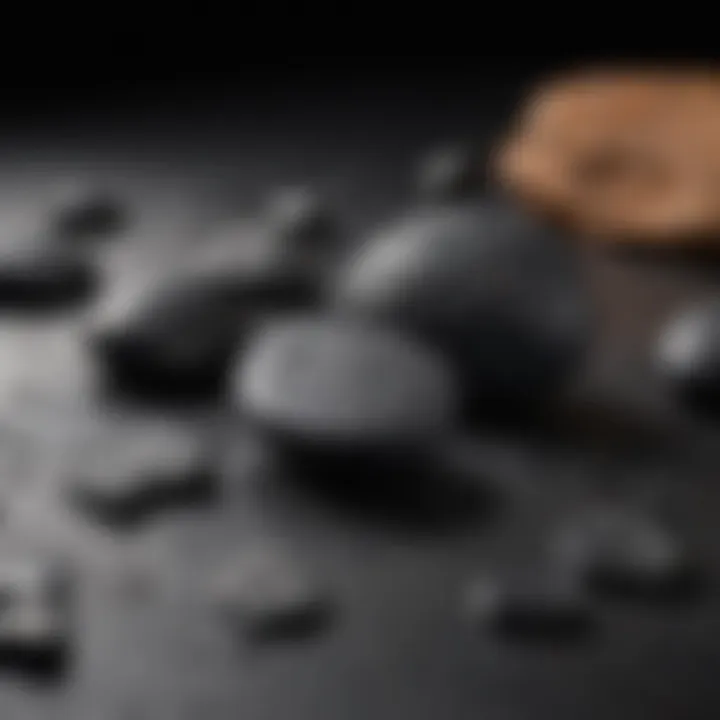Identifying Black Stones: An In-Depth Guide


Intro
Black stones captivate the eye and stir the curiosity of geologists, collectors, and casual enthusiasts alike. Their unique visual qualities, along with intriguing histories, make them fundamental within the realm of mineralogy. Each specimen tells a story, woven from natural processes, human culture, and, at times, even mythology. This guide serves as a roadmap, navigating the diverse landscape of black stones, covering identification techniques, cultural significance, and collectible specimens.
To appreciate black stones is to delve into their distinct characteristics and qualities. Whether you're examining sleek obsidian, lustrous black tourmaline, or rich basalt, each has its own personality. The journey of identifying these stones begins not simply with aesthetics but with a deeper understanding of their formation and context.
As we march forward, this article will unravel methods on identification, emphasizing visual traits and hardness testing, while also highlighting tools available for identification. Also, by weaving in geological sharings and anecdotes that underline the cultural importance of these stones, we can unveil how they have resonated through time.
Consider this not just an academic exploration, but a chance to connect with the very fabric of our Earth. Whether you seek to hone your identification skills or simply wish to appreciate the beauty of nature's creations, this guide aims to equip you with valuable insights.
Understanding Black Stones
Black stones are more than just dark pebbles scattered across riverbeds or sitting in a quarried pile waiting for a builder. They represent a vast array of geological phenomena and have intriguing stories etched into their very structures. The understanding of black stones provides rock and fossil collectors critical insights into their unique properties, diverse classifications, and significance in the natural world.
Why delve into this topic? For starters, recognizing the type and characteristics of a black stone can increase one’s ability to identify valuable specimens and appreciate their geological significance. Moreover, each type of black stone has its own distinct attributes — from formation processes to uses throughout history — that enrich the narrative of our Earth’s evolution.
Exploration of black stones illuminates crucial factors such as their chemical composition, where they fit into the broader geological framework, and why certain specimens are sought after by collectors. Having an understanding of this subject equips enthusiasts with tools for making informed assessments and decisions regarding their collections.
Definition and Characteristics
Defining black stones is not as straightforward as one might think. At a glance, the term encompasses various minerals and rocks, each boasting distinctive features that can set them apart. Generally speaking, a black stone is identified by its dark coloration, which can range from pitch black to a deep charcoal or slate hue.
Characteristics of black stones often include:
- Color: Often their most striking feature, black stones can exhibit a spectrum of shades influenced by mineral content.
- Luster: From glassy obsidian to dull basalt, the surface sheen varies widely among types.
- Texture: Some are smooth and polished, while others may be rough and jagged.
- Formation: Black stones come from igneous, sedimentary, or metamorphic processes, each contributing to their unique identities and appearances.
In essence, the character of a black stone lies hidden beneath its surface, waiting for an astute observer to extract its history.
Importance in Geology
The importance of black stones in the geological spectrum cannot be overstated. They serve as indicators of the Earth’s processes, revealing information about past environments and the conditions that shaped them. For instance, igneous black stones like basalt are formed from the cooling of magma, providing hints about volcanic activities and tectonic movements from ages past.
Moreover, black stones act as natural time capsules. Understanding their formation processes sheds light on:
- Erosion and weathering: The durability of certain black stones indicates how they have resisted break down over millions of years.
- Geographic distribution: Specific types of black stones appear in certain areas, providing clues about historical plate movements and climate shifts.
- Resource utilization: Throughout history, black stones like obsidian have been used as tools or ornaments, showing how humans adapted to their environments.
In summary, black stones encapsulate intriguing geological narratives that enhance our understanding of the Earth. Their study is paramount not just for academic discourse but also for collectors who seek to appreciate the beauty and significance of their natural pieces.
Categories of Black Stones
The realm of black stones is vast and varied, each category holding its unique significance and character. Understanding these categories not only aids identification but also deepens appreciation for the geological processes that give birth to these minerals. Recognizing the distinctions between igneous, sedimentary, and metamorphic black stones opens a world of insights for collectors, hobbyists, and scholars alike.
Igneous Black Stones
Igneous black stones form from the cooling and solidification of molten rock. There are two key categories: intrusive and extrusive. Intrusive stones, like granite, solidify slowly beneath the earth’s surface, while extrusive stones, such as basalt, cool rapidly after erupting from volcanoes. While granite often carries a blend of colors, basalt is predominantly black, making it one of the most recognizable igneous stones.
Another important igneous black stone is obsidian. This glassy material, formed through rapidly cooling lava, presents a shiny, almost mirror-like surface. The unique feature of obsidian is its conchoidal fracture, resembling the curve of a shell when broken.
Key Identification Traits of Igneous Stones:
- Texture: Often smooth or glassy in the case of obsidian.
- Composition: Contains minerals like plagioclase and olivine, detectable via scratch tests.
Sedimentary Black Stones
Sedimentary stones tell a different story, originating from the accumulation and compaction of mineral and organic particles. Coal is a prominent example of a black sedimentary rock, formed from compressed plant material over millions of years. Each type, from anthracite to lignite, exhibits a distinct texture and burning properties that can aid in identification. Additionally, shale can be black due to the presence of organic material or iron sulfides.
Distinguishing Features of Sedimentary Black Stones:
- Layers: Often shows stratification, revealing its historical deposition in nature.
- Fossils: May contain traces of past life, providing historical context.
Metamorphic Black Stones
When existing rocks undergo pressure and heat, metamorphic rocks emerge, transforming their predecessors. Black slate is a quintessential example, derived from shale and often characterized by its smooth, fine-grained texture. Graphite, another metamorphic stone, is notable for its metallic luster and softness, making it easy to write with, which points to its unique structure and formation processes.
Characteristics to Note in Metamorphic Stones:
- Foliation: Layers can be distinct due to pressure during formation.
- Hardness: Varies widely based on the original rock type and conditions under which metamorphism occurred.
Identifying black stones involves understanding their formation—whether they crystallized from lava, settled from sediment, or transformed under heat and pressure.
In this exploration, categorizing black stones by their formation not only sharpens identification skills but reveals geological narratives that are centuries, if not millennia, in the making. By dissecting these categories, one gains insight into the earth itself, crafting a deeper bond with these fascinating geological formations.
Key Identification Factors


Identifying black stones requires keen observation and understanding of several pivotal elements. Black stones, while seemingly homogenous at first glance, exhibit a variety of unique characteristics that can aid in distinguishing one type from another. The significance of these key identification factors lies not only in the ability to accurately recognize specific stones but also in appreciating their geological background and practical uses. This section delves into three crucial aspects: color and luster, texture and aesthetics, and hardness and density.
Color and Luster
The color of a stone often serves as its most immediate identifier. Black stones can range from a deep, glossy obsidian to the duller, matte surface of coal. Observing the color’s intensity can provide clues to the stone's composition and origin. The luster adds another layer of identification; it describes how light interacts with the stone’s surface. For instance, obsidian often displays a vitreous luster, giving it that striking shine, while basalt may appear more earthy and subdued.
When assessing a stone’s color, it's useful to consider variations due to impurities or incorporation of other minerals. In some instances, even a slight sheen can indicate the presence of iron or other metallic elements. This can be observed especially in basalt, where it might suggest a higher mineral content than other black stone varieties.
Texture and Aesthetics
Texture encompasses more than just how a stone feels to the touch. It includes the grainy, smooth, or uneven surface patterns that can provide valuable identification information. For example, basalt typically has a rougher texture due to its volcanic origin, while jet, derived from decayed wood, may be polished to a satin-like finish. Observing the surface aesthetics is vital when determining the stone's history and formation, which are often intertwined.
It's also essential to think about the stone's overall appearance—veining, inclusions, or even patterns can differentiate similar stones significantly.
"The aesthetic attributes of a black stone do not merely enhance its beauty but serve as a mirror reflecting the environment from which it emerged."
In collecting or academic discussions, such details can lead one to recognize the specific geological conditions under which the stone formed.
Hardness and Density
Hardness determines how resistant a stone is to scratching and wear. The Mohs scale of mineral hardness can be a useful benchmark in identifying black stones. For instance, the natural hardness of coal is significantly lower than that of basalt or obsidian. Testing for hardness might involve scratching the stone with a tool of known hardness, such as a knife or nail, observing which materials leave marks.
Density, on the other hand, can be measured by weighing the stone and comparing it to its volume. While novices might not always have the tools at their disposal, even a simple water displacement method can yield surprising insights into a stone’s characteristics. Understanding how density correlates with geological formation can tell a collector much about the stone’s history and rarity.
In summary, these key identification factors—color and luster, texture and aesthetics, and hardness and density—form the backbone of our ability to recognize and classify black stones. Mastery over these elements equips collectors with the knowledge needed to deepen their appreciation and understanding of these remarkable geological specimens.
Visual Identification Techniques
In the realm of geology and mineralogy, visual identification techniques stand as fundamental tools for distinguishing various types of black stones. These methods are not merely practical; they often serve as the initial filters through which collectors, geologists, and hobbyists approach their specimens. Understanding how to accurately assess the appearance of these rocks is crucial since many black stones possess overlapping characteristics. A keen eye can make all the difference in identifying the specific type of stone, whether it be volcanic, sedimentary, or coal-based.
Employing visual identification techniques empowers individuals to engage with their specimens in a more meaningful way, enhancing appreciation and developing expertise over time. A few key benefits of these techniques include:
- Immediate Recognition: Identifying the stone visually can yield quick insights into its potential classification.
- Reduction of Misidentification: By recognizing distinctive features, one can avoid the pitfall of confusing similar-looking stones.
- Foundation for Further Testing: The insights gained through visual identification can guide further investigation using more profound methods like hardness or acid testing.
Using a Magnifying Glass
Using a magnifying glass is a low-cost way to elevate the examination process of black stones. By increasing the visual detail one can observe, this handy tool reveals intricate features that may otherwise elude the naked eye. For instance, the surface texture of a stone, which can tell you a lot about its formation process, becomes much more apparent when observed under magnification.
When using this technique, focus on:
- Surface Patterns: Some black stones, like obsidian, exhibit natural patterns or flow lines, while others can be more homogenous.
- Inclusions: Tiny particles or other minerals trapped within the stone offer clues about its geological history.
To utilize this method effectively, hold the magnifying glass about two to four inches away from the stone and adjust the distance to achieve a clearer view. It is almost like discovering an entirely new object, one that has secrets locked within its structure waiting to be revealed.
Comparative Analysis with Known Samples
The comparative analysis with known samples is a practice in identifying black stones that holds tremendous value, yet can be somewhat overlooked. Imagine line-ups of your specimens alongside reliable references, such as basalt gathered from a local quarry or a piece of jet you acquired from a collector. Each stone will have unique characteristics that can be assessed side by side.
Through this technique, one can:
- Establish Baselines: Knowing the standard traits for common black stones allows for easier identification of anomalies.
- Reveal Subtle Differences: Variations in lustre, color, or texture become more pronounced when juxtaposed against a known comparative specimen.
- Build Confidence in Identification: The more familiar you become with particular stones, the more adept you'll be at quickly identifying them in the field or at a site.
In practice, lay the stones out in a well-lit area, preferably with a white background to help accentuate their unique features. Then, take your time comparing the characteristics meticulously, jotting down notes or impressions as you go.
"The eye sees only what the mind is prepared to comprehend." - Robertson Davies
Utilizing visual identification techniques not only boosts one's knowledge-base but also deepens the enjoyment of exploring and identifying black stones in both personal collections and fieldwork.
Geological Context
Understanding the geological context of black stones is crucial for anyone looking to identify and appreciate these fascinating specimens. Geological context encompasses the processes that lead to the formation of these rocks, as well as their distribution across various regions of the planet. It labels the narrative of how black stones emerge from the Earth’s crust, highlighting not only their physical traits but also the historical and environmental factors contributing to their characteristics. Without this backdrop, one might merely see a rock; with it, you gain insight into the Earth’s inner workings.
Formation Processes
The formation of black stones can occur through three primary geological processes: igneous, sedimentary, and metamorphic. Each process shapes the stones uniquely, leading to varying properties and appearances.
- Igneous Formation: This occurs when molten rock cools and solidifies, either beneath the surface or after a volcanic eruption. For example, obsidian is a type of igneous black stone formed when lava cools rapidly. Its glassy texture and sharp edges make it distinctive.
- Sedimentary Formation: In contrast, sedimentary black stones arise from the accumulation of minerals and organic materials over time. Coal is a prime example, formed from ancient plant matter buried and subjected to heat and pressure, introducing an element of fossilized history to its identity.
- Metamorphic Formation: Lastly, metamorphic black stones are products of existing rocks changed by immense heat and pressure. For instance, slate starts as shale but transforms into a tougher, more compact stone with a characteristic sheen.
Each formation process not only influences the physical properties of the stones but also adds layers of story and context about the Earth's geologic activity over millions of years. Recognizing how a stone is formed enriches the identification process, providing clues about its history and origin.
Geographical Distribution
The geographical distribution of black stones serves as a narrative map for rock and fossil collectors. These stones are not randomly scattered; rather, they occur in specific regions based on geological processes and history.


- Obsidian is frequently found in volcanic regions, such as the western United States and parts of Iceland. Its presence is a strong indicator of historic volcanic activity.
- Basalt, on the other hand, shows up in vast plateaus like the Columbia River Basalt Group and in locations such as Iceland, where it forms the foundation of the landscape.
- Jet is generally located close to the coastlines of certain areas, such as Yorkshire in England, derived from ancient forests that once flourished in those locations.
- Coal, vital for energy and industrial applications, can be found in sedimentary basins across the globe, with notable deposits in the Appalachian region of the United States.
Such geographical insights not only enhance the identification experience but also position collectors to appreciate the interplay between landforms and the resources they uncover. Furthermore, being aware of a stone's distribution can guide collectors in areas to explore for their finds, making the pursuit more effective and grounded in geological reasoning.
The geological context of black stones is not just about the rocks themselves; it’s about the tales they tell through their formation and distribution across the Earth.
An understanding of these concepts arms collectors and hobbyists alike with valuable knowledge, ultimately elevating their ability to appreciate and identify black stones in their full complexity.
Common Types of Black Stones
When diving into the world of black stones, it’s essential to understand the key players in this realm. Each type comes with its own unique properties, making them significant both for practical identification and for their geological and cultural relevance. For rock and fossil collectors, knowing the common types of black stones can enhance your appreciation and expertise in the field.
Obsidian
Obsidian, often known as volcanic glass, is a striking black stone that results from rapidly cooled lava. It possesses a glassy texture and can be found in varying shades of black, often featuring subtle dark green or brown hues. The importance of obsidian lies not only in its aesthetic appeal but also in its historical use. Ancient civilizations utilized obsidian for crafting tools and weapons due to its sharp edges.
If you're trying to identify obsidian, look for a smooth surface that reflects light like glass. The stone’s fracture is conchoidal, meaning it breaks in a shell-like pattern which is typical for glassy materials. When held up to the light, proper obsidian can sometimes reveal translucent edges.
Basalt
Moving on to basalt, you'll find this stone is one of the most abundant volcanic rocks on Earth. It’s generally a dense, black rock formed from the rapid cooling of basaltic lava. The key characteristic of basalt is its fine-grained texture, which can sometimes make it hard to distinguish it from other types. For collectors, it’s crucial to note that basalt can display a slightly rougher surface compared to the sleek finish of obsidian.
In the broader context, basalt plays a significant role in defining landscapes, particularly in regions with volcanic activity. It can also be used in construction, making it a practical choice beyond mere appreciation.
Jet
Jet, a type of lignite coal, is an organic gemstone formed from the fossils of wood subjected to heat and pressure over millions of years. Its deep black color and silky sheen make it a favorite among jewelry makers. The significance of jet is perhaps most evident in its historical use. Jet has been used in mourning jewelry, particularly during the Victorian era, symbolizing remembrance.
When identifying jet, you might notice it being relatively lightweight compared to other black stones. A simple test involves rubbing it against your skin, which may produce a faint static charge. Additionally, jet has a distinct earthy smell when burned, reminiscent of burning wood. Its unique nature makes it a fascinating piece for collectors.
Coal
Lastly, there’s coal—commonly overlooked but still significant among black stones. Coal is primarily used as a fuel source; however, its geological importance cannot be understated. Formed from decaying plant material over centuries, coal varies from soft to hard forms, each with its own density and luster.
When acting like a collector, consider the various types of coal: anthracite, bituminous, sub-bituminous, and lignite. Anthracite is very hard and shines when polished, whereas lignite retains a softer texture. Knowing these differences can aid in proper classification and appreciation of coal specimens. While commonly associated with energy production, its presence in geological formations serves as a marker for past environments.
Understanding the characteristics and uses of these common black stones provides valuable context for both their natural properties and their roles in human history.
By mastering these types, you set yourself up for success in collecting and identifying various specimens of black stones. Whether obsidian's sharp edges, basalt's geological impact, jet's organic origins, or coal's historical significance catches your fancy, each stone tells a story waiting to be unveiled.
Practical Identification Methods
Identifying black stones is an intricate dance with geology and mineralogy, where knowing the right techniques can turn an intimidating endeavor into a straightforward task. Practical identification methods are vital in this context, offering rock and fossil collectors a toolkit to discern between the shades of black stones they might encounter. These methods do not only provide clarity but also impart a deeper connection with the material being studied, fostering appreciation and understanding of the natural world.
In this section, we will unravel two particularly effective methods for identifying black stones: acid testing and scratch testing. These practical techniques will not only bolster your identification skills but also embolden you in your collecting journey.
Acid Testing
Acid testing serves as a reliable method for identifying certain types of black stones, particularly those in the carbonate family. The fundamental principle behind this method is simple: a reaction occurs when acid comes into contact with calcium carbonate, resulting in effervescence. For black stones like limestone or dolostone, this reaction can reveal much about their composition.
To perform acid testing accurately, collect a few drops of vinegar or a diluted hydrochloric acid solution. Apply it carefully to a discreet area of your stone. If it bubbles and fizzes, you've likely encountered a carbonate.
However, caution is key. Here are some considerations:
- Always conduct acid testing in a well-ventilated area.
- Use proper safety gear—gloves and goggles are a must.
- Test only on inconspicuous areas to preserve the integrity of your specimen.
"Acid testing doesn't just identify materials; it unveils the history and stories intertwined with the earth’s formation."
This technique, while straightforward, requires a certain finesse. Factors like the age of the stone, its surroundings, and the conditions under which it formed can all play a role in its response to acid. Thus, one must have a keen eye and an understanding of geological contexts when interpreting results.
Scratch Testing
Scratch testing, on the other hand, provides insight into the hardness and durability of a black stone. This method is grounded in Mohs hardness scale, which ranks minerals from 1 (talc) to 10 (diamond). By trying to scratch the surface of your stone with a reference material, you can gauge its resistance and thus its classification.
Common materials you can use for scratch comparison include:
- Fingernail (hardness of about 2.5)
- Copper coin (about 3.5)
- Steel knife (around 5.5)
To perform the test:
- Choose a less visible area of your stone to prevent damage.
- Attempt to scratch the surface with the reference material.
- Observe whether a mark is left or if the reference material gets scratched instead.
A successful scratch indicates the hardness of your specimen and can point you toward its identity. For example, if your specimen scratches easily, it may be a soft material like obsidian, whereas a harder stone like basalt will resist such a test. Keep in mind:


- Each stone has unique hardness properties, and understanding these will lead you to more accurate identifications.
- This test might remove a tiny bit of the surface, so always be cautious with your method.
The Role of Technology in Identification
In the modern era, technology has woven itself into countless aspects of our lives, and the identification of black stones is no exception. The advancements in technology not only streamline the identification process but also enhance the accuracy of assessments, making it easier for rock and fossil collectors to discern between similar specimens. Understanding these high-tech methods is essential as they unveil details in a stone that the naked eye may not perceive.
These technological tools are paramount for various reasons:
- Precision: Tools such as digital microscopes and spectroscopy techniques can provide insights that help differentiate subtle variations between stones.
- Accessibility: With technology, even novice enthusiasts can gain access to professional-level identification, aiding in education and promoting better conservation practices.
- Documentation: High-quality imaging and analysis tools allow for precise recording of findings, which can be invaluable for research.
In summary, incorporating technology into black stone identification not only sharpens the process but also deepens understanding, leading to informed choices and appreciation.
Digital Microscopy
Digital microscopy represents a leap forward from traditional methods of examining stones. This technique uses high-resolution cameras to capture detailed images, allowing collectors to zoom in on the intricate structures of minerals. One key advantage is the ability to observe mineral inclusions or micro-crystals that can define a stone's identity.
This method is not merely for those in labs; it's increasingly available for hobbyists. With online platforms offering affordable digital microscopes, anyone with enthusiasm can explore the microscopic world. Furthermore, it enables the possibility for sharing findings in online communities, creating a collaborative learning environment among collectors.
"Digital microscopy opens a window into a previously invisible world of details, enriching the field of mineral identification."
Spectroscopy Techniques
Spectroscopy is another powerful tool that has gained traction in the identification of black stones. This technique involves analyzing the light emitted or absorbed by a rock to determine its composition. Different minerals reflect and absorb light in unique patterns, allowing for specific identification.
While it may sound complicated, the equipment has become more user-friendly. Devices like handheld spectrometers can be employed on-site, helping collectors quickly gain insights without sending samples to laboratories. This immediacy enhances the fieldwork experience and allows for prompt decisions regarding hypotheses in geological studies.
Moreover, spectroscopy can uncover information about a stone's chemical properties and environment of formation, providing an overarching context to its presence. Collectors with a keen interest in geology might find these insights particularly enriching, leading to a more profound appreciation for their specimens.
Utilizing such advanced techniques in the field of geology not only empowers collectors but also fosters a deeper connection to the intricate stories behind each black stone.
Cultural Significance of Black Stones
Black stones hold profound importance across various cultures, offering not just aesthetic appeal but also enriched narratives that connect humanity with the earth. These geological wonders have found their place not only in the realms of geology and mineralogy but also in the stories, traditions, and customs of different societies. Understanding the cultural significance of these stones sheds light on how they influence art, belief systems, and human interactions with nature.
Historical Uses
Throughout history, black stones have been employed in a myriad of practical and symbolic applications.
- Tools and Weapons: The sharp edges of obsidian, a volcanic black glass, made it a popular choice among ancient civilizations for crafting tools and weapons. From arrowheads to cutting implements, this material offered both durability and precision, essential in survival. Many archaeologists have unearthed remnants of such tools, indiciating their wide prevalence across different societies.
- Building Materials: In architecture, basalt has been a favored choice for construction due to its strength and abundance. The Aztecs, for instance, used basalt in their temples and sculptures, the dark color adding a unique character to their monumental sites.
- Jewelry and Art: Black stones like jet and coal have played a critical role in ornamental crafts. During the Victorian era, jet became a popular choice for mourning jewelry, symbolizing loss while providing beauty through its deep, rich luster. This use is a testament to how black stones can carry significant emotional weight, tied to both personal and cultural narratives.
"Black stones are not merely geological specimens; they embody stories of civilizations that came before us," says an expert in mineralogy.
Symbolism Across Cultures
The symbolism attached to black stones varies greatly across cultures, often embodying themes of transformation, power, and protection.
- Spirituality and Protection: In many indigenous traditions, black stones are seen as protective talismans. For example, in some Native American cultures, black stones are believed to ward off negative energies, offering security to those who carry them.
- Transformation and Rebirth: In certain Eastern philosophies, black stones can represent transformation. Their formation from cooling lava is often viewed as a metaphor for resilience and the ability to rise from one’s challenges, much like the phoenix of myth and lore.
- Cultural Artifacts: The role of black stones in religious and cultural artifacts cannot be understated. Statues and amulets made from black stones are often seen in various rituals worldwide, symbolizing strength and steadfastness. The continuity of using these stones in disparate cultural contexts speaks volumes about their universal significance.
Preservation of Black Stones
Preserving black stones is a crucial aspect that often goes overlooked. For collectors, hobbyists, and scholars, the integrity of these geological specimens is paramount. The way stones are handled and stored can directly affect their appearance, composition, and overall value. With the right preservation techniques, you ensure that these fascinating materials remain in the best possible condition for future appreciation and study.
Proper Handling Techniques
When it comes to black stones, the way you handle them can either make or break your collection. Here are some key considerations to keep in mind:
- Clean Hands: Before touching any stone, it's important to have clean, dry hands. Oils and dirt can easily transfer onto the stone's surface, possibly causing damage or altering its appearance.
- Gentle Touch: Always handle stones with a gentle grip. Avoid squeezing too tightly, as this can lead to fractures or breakage. A light yet secure hold is ideal.
- Avoid Direct Sunlight: Prolonged exposure to sunlight may fade the color of some black stones. If you're examining them, do so in a well-lit area, but avoid keeping them in direct sunlight for extended periods.
- Use Soft Tools: If using tools like tweezers or brushes, make sure they are soft to avoid scratching or damaging the stone. For example, a soft brush can effectively remove dust without harming the surface.
Storage Recommendations
Proper storage is just as important as handling techniques. Ensuring that your black stones are stored correctly can prevent damage and prolong their life. Here are some recommendations:
- Use Soft Pouches: When not on display, store each stone in a soft cloth pouch or a dedicated box. This prevents scratches and keeps stones from jostling against each other.
- Temperature Stability: Keep your collection in a stable environment. Extreme temperature fluctuations can cause stones to expand or contract, potentially leading to cracks.
- Humidity Control: High humidity can damage certain types of stones, especially those that are porous like coal or jet. It's wise to keep them in a climate-controlled area to maintain a proper humidity level.
- Display Cases: Utilize display cases that protect stones from dust and are resistant to UV light. This offers additional protection while allowing for easy viewing without direct sunlight exposure.
Tip: Regularly check your stones for any signs of damage or deterioration. Early intervention can save a prized specimen from further harm.
In keeping black stones preserved, you're not just safeguarding a collection; you're maintaining the stories and processes that formed these geological wonders. This attention to preservation reflects a respect for nature's art and a commitment to ongoing education and appreciation of the field.
Ending
In this article, the key focus has been on the identification of black stones, a subject that holds significant value for enthusiasts and collectors alike. Grasping the essentials of how to recognize and understand these stones not only enriches one’s collection but also enhances the appreciation for geology as a whole.
The importance of the conclusion lies primarily in synthesizing the myriad elements explored throughout the text. It ties together the significance of the various types of black stones discussed, from obsidian known for its volcanic origins to jet, often recognized for its organic nature. Recognizing these distinctions not only impacts collection practices but can also aid in geological surveys and educational endeavors.
Additionally, highlighting the practical methods for stone identification—like acid and scratch testing—not only underscores the validation of authenticity but also engenders a deeper connection to the material world we study.
"Knowledge of black stone types empowers collectors to make informed decisions and fosters a greater appreciation for the intricacies of geology."
This guide serves to equip hobbyists with the fundamental knowledge requisite for discerning between various stones. By emphasizing the importance of careful observation, contextual geological understanding, and cultural significance, readers develop a multi-faceted perspective on black stones.
In closing, it’s critical to consider not just the stones themselves, but also the various narratives they carry—stories of ancient geological processes, cultural usages, and even personal significance. Preservation methods and storage recommendations also pose important considerations for anyone looking to maintain their collection in top-notch condition. Ultimately, this comprehensive exploration sheds light on the depth and beauty of black stones, making them more than just collectibles, but artifacts of nature's extensive history.



